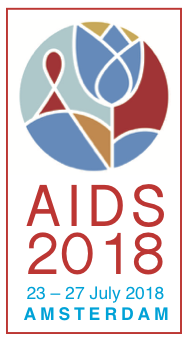Using PrEP with feminising hormone therapy supports daily PrEP dosing for transwomen
3 August 2018. Related: Conference reports, PK and drug interactions, HIV prevention and transmission, World AIDS 22 Amsterdam 2018.
Simon Collins, HIV i-Base
 Two studies were publicised by AIDS 2018 several weeks before the conference with a suggestion that there might be a safety concern linked to interactions between PrEP and feminising hormone therapy (FHT).
Two studies were publicised by AIDS 2018 several weeks before the conference with a suggestion that there might be a safety concern linked to interactions between PrEP and feminising hormone therapy (FHT).
In practice, now the studies have been presented, the results do not seem an important concern. PrEP drugs do not affect the levels of FHT and the possible interactions to reduce tenofovir in PrEP does not seem clinically significant.
Both studies involved very small numbers of participants and reported observations that are not directly related to PrEP efficacy. The results should not limit effectiveness for transgender women of each treatment, though the results emphasise the importance of using daily-dosing for PrEP.
The first study, presented in a later breaker poster discussion by Akarin Hiransuthikul from the Thai Red Cross AIDS Centre in Bangkok, was included in the official AIDS2018 press conference. [1]
Between January to March 2018, the study enrolled 20 transwomen who had not underwent orchiectomy and had not used injectable FHT in the previous six months. This single arm study included five weeks of FSH (estradiol valerate 2 mg and cyproterone acetate 25 mg), with PrEP added at week 3 and continued to week 15. FHT was started again from weeks 8 to 15, enabling each participant to be their own control for all drug and hormone levels measured at weeks 3, 5, 8.
There were no significant changes in PK parameters for FHT levels with and without PrEP.
Although the reduced levels of tenofovir exposure in plasma when taken with FST were statistically significant, the 13% reduction in AUC and 17% reduction in C24 are unlikely to have clinical significance with daily dosing.
The second study was presented by Mackenzie Cottrell and colleagues from University of North Carolina and used a different approach. This group compared intracellular drug levels in rectal tissue in four transgender women compared to four cis-gendered women who were already on TDF/FTC-containing ART. FHT included oral or injectable E2, medroxyprogesterone, and spironolactone. In addition to the drug levels, the group reported levels increased levels of endogenous triphosphate levels (dATP/dCTP) that if increased by FHT might reduce levels of PrEP drugs.
Although the TDF-dp:dATP ratio was 7-fold lower in trans compared to cis woman, the clinical implications of the results are not clear. Target levels have not been defined and daily PrEP might still achieve protective levels. Also, one comment in questions after the presentation suggested that drug levels in rectal tissue might not be the most important tissue to measure. The results were also compared with a very small group of cisgendered men (n=2).
comment
In addition to this study having small participant numbers, the absolute TFV-dp levels were still similar. The lower ratio highlights transgender TGW for having slightly lower TFV-dp, and slightly higher dATP.
If the FHT is really having a negative effect then the results in ciswomen and the cismen ought to have been different and this wasn’t seen.
Clinical results from the iPrEX study showed the benefits of PrEP in more than 300 transgender women, although only 20% of these women (67/339) were using FHT. [3, 4]
As with most questions about trans health, this shows the importance of earlier prospective studies continued collection of data from ongoing PrEP studies.
References
- Cottrell ML et al. Altered TDF/FTC pharmacology in a transgender female cohort: Implications for PrEP. TUPDX0106.
http://programme.aids2018.org/Abstract/Abstract/11225 - Hiransuthikul A et al. Drug-drug interactions between the use of feminizing hormone therapy and pre-exposure prophylaxis among transgender women: The iFACT study. TUPDX0107LB.
http://programme.aids2018.org/Abstract/Abstract/13177 - Collins S. PrEP efficacy for transgender women: new analysis from iPrEX study. HTB, December 2015.
https://i-base.info/htb/29275 - Deutsch MB et al. HIV pre-exposure prophylaxis in transgender women: a subgroup analysis of the iPrEx trial. The Lancet HIV (2015). 2(12)e512–e519, December 2015(05 November 2015).
https://doi.org/10.1016/S2352-3018(15)00206-4

